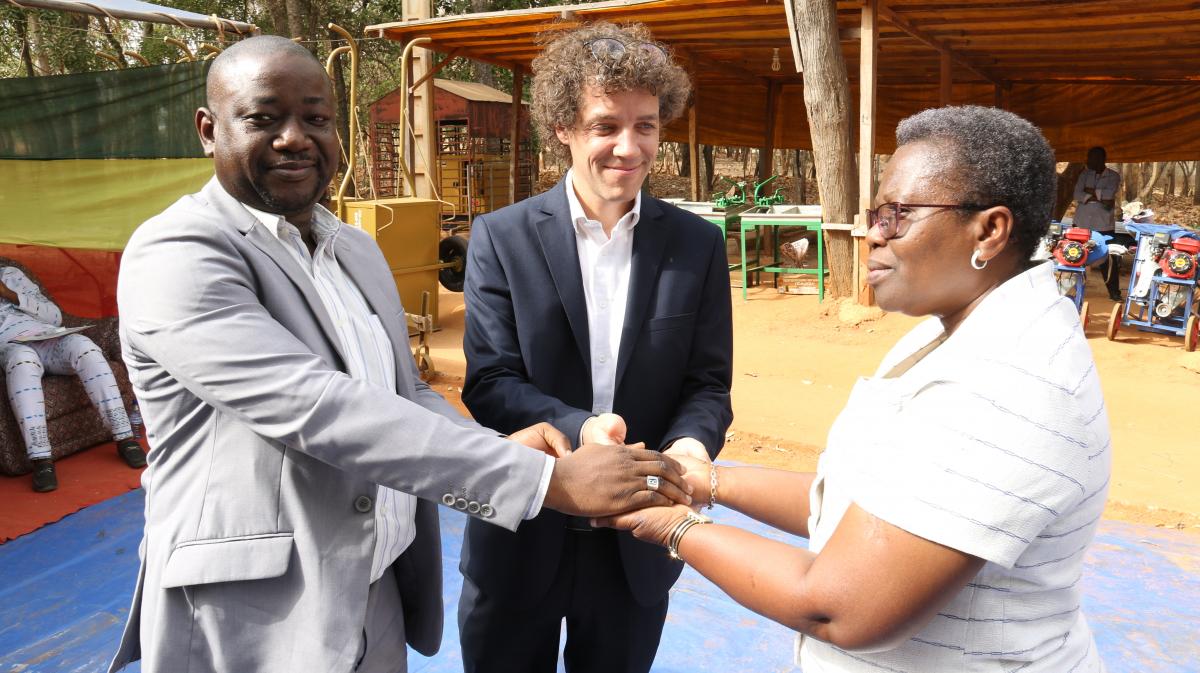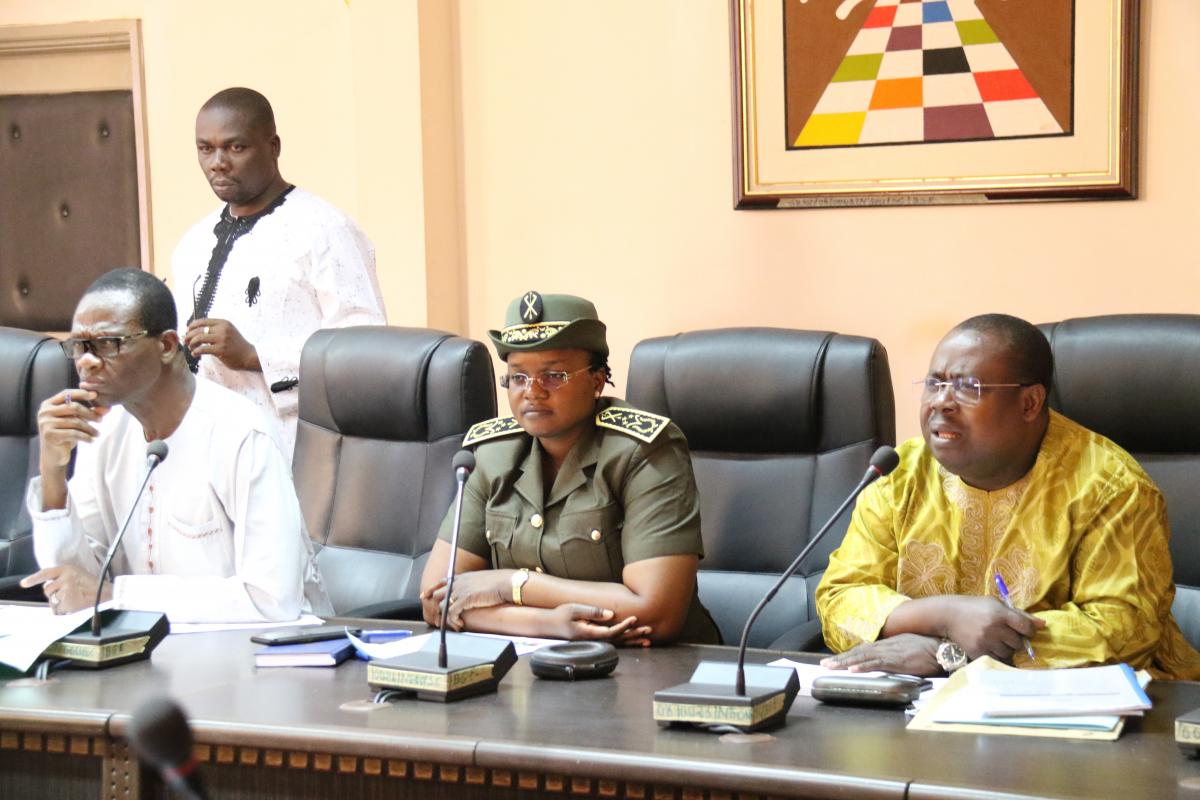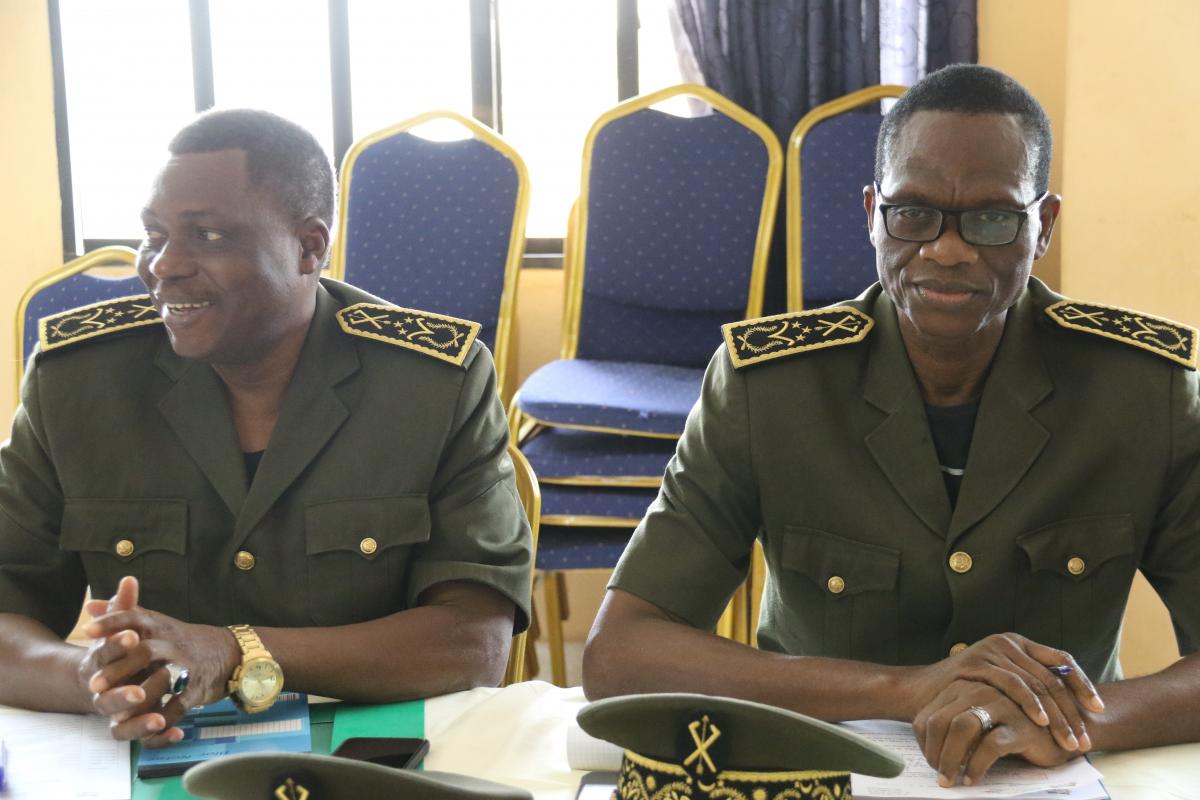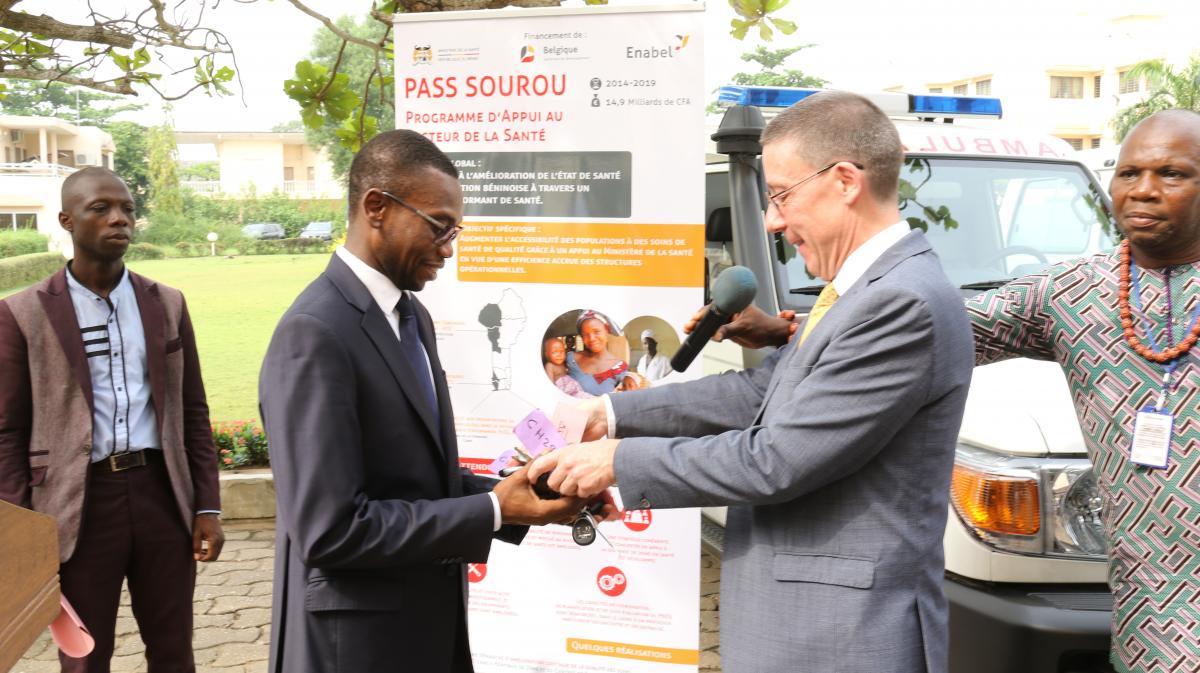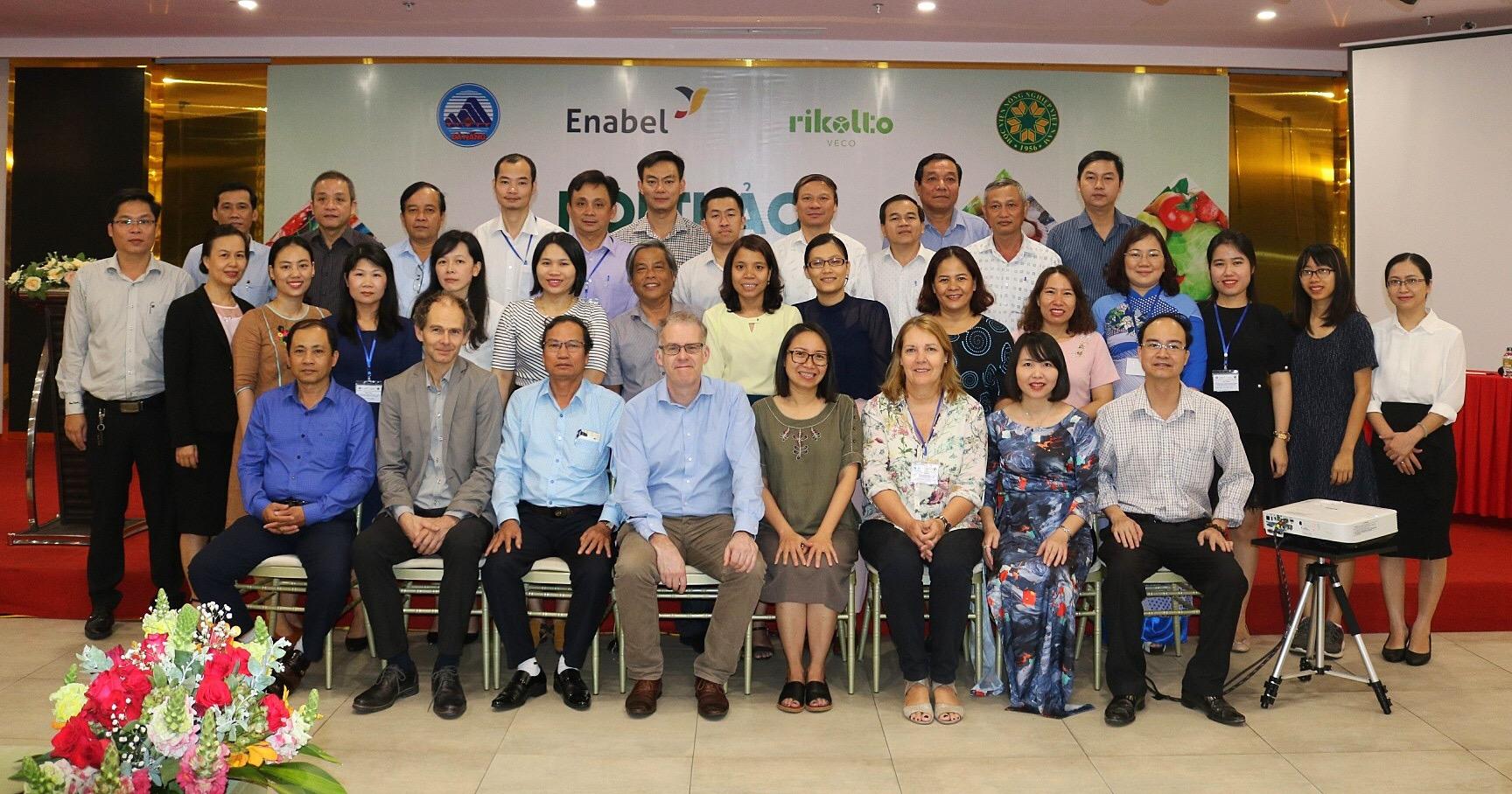Rechercher
Affichage de 2310 à 2325 sur 3055 actualités
-
1179 bénéficiaires membres des coopératives agricoles dont 570 femmes reçoivent du matériel et des équipements
Reece-hermine ADANWENON | 22/03/2019
L'unité Fonctionnelle et Régionale de l’Atacora et de la Donga (UFR) du Programme d'Appui au Développement des Filières Agricoles (PROFI) a procédé le jeudi 20 février 2019 à la remise officielle d’un lot important d’équipements et matériaux aux promoteurs des Microprojets de production et de Commercialisation (MIC)et les porteurs de projets d’entreprenariat agricole (PEA). D'un montant total de 250.000.000 de FCFA, ces équipements sont composés de 05 tracteurs de 72 CV et des accessoires, de 21 batteuses vanneuses de riz, de 03 batteuses épierreuses de riz, de 67 Charrues pour la culture attelée, 37 charrettes à traction asine et 09 décortiqueuses manuelles de noix d'Anacarde installées sur sa table. La mise en place de ces équipements impactera environ 1179 bénéficiaires membres des Coopératives dont 570 sont des femmes soit 51%. Dans son mot introductif, Kader Toko Worou, responsable de l'Unité Fonctionnelle et Régionale Atacora et Donga du PROFI a expliqué le processus de préparation, de sélection et d'attribution des Microprojets de production et de commercialisation et les Projets d'entrepreneuriat agricole (PEA). Selon lui, sur 173 dossiers présélectionnés 133 ont été retenus et sont en cours de financement à travers divers appuis allant des infrastructures (aménagement hydro- agricole, bâtiments de stockage et de transformation) ...aux équipements (tracteurs, décortiqueuses de riz, de noix d'Anacarde, de tricycle, motoculteurs, batteuses vanneuses, charrues, charrettes). Monsieur Kader Toko Worou, a ajouté que dans le même processus, Enabel en plus de l’appui financier, accompagne les promoteurs bénéficiaires en mettant à leur disposition une assistance technique constituée de quatre ressources humaines. Le premier intervient en conseil de gestion et commercialisation, le second en maître d’ouvrage, le troisième en aménagement hydroagricole et le quatrième en appui à l’entreprenariat rural. Il est également mise à la disposition une prestation de service non financier offert par deux structures en vue de rendre l’exploitation des investissements/matériels et équipements optimale et durable. Monsieur Christophe MEGBEDJI, préfet du département du Couffo, représentant Mme Lydie Dérè CHABI UnNAH, préfet du département de l'Atacora a souligné que les interventions du Programme PROFI à travers l'initiative de Enabel au Bénin sont en parfaite harmonie avec le Programme d’action du Gouvernement (PAG). « C'est une coopération dynamique qui permet au Bénin d'amorcer son développement » a-t-il indiqué. Pour Monsieur Olivier HECK, Représentant Résident de l’Agence belge de développement au Bénin dira que chaque équipement servira en priorité à renforcer les activités des membres des différents groupements bénéficiaires en offrant notamment le service de labour, de post-récolte, de transport et de transformation. « Les coopératives s’organiseront également pour offrir des prestations des mêmes services aux autres acteurs non membres. C’est le cas notamment des tracteurs dont les capacités sont très importantes (72 CV). Les recettes de ces prestations seront utilisées pour l’entretien et la reconstitution du fond d’amortissement. Il s’agit bien sûr des subventions octroyées aux acteurs directs qui mobilisent une contrepartie variant de 5 à 10% du montant global du projet », a-t-il souligné. Il convient également de retenir qu’au-delà de l’appui matériel, les bénéficiaires reçoivent également un appui technique axé sur les outils de gestion d’une exploitation agricole. Ces appuis visent à les professionnaliser pour une utilisation plus efficiente des infrastructures ou équipements reçus. Ces mesures visent à garantir une durabilité qui va au-delà même du projet. Le but visé est que chaque bénéficiaire soit capable de reconstituer l’investissement après amortissement. Madame Françoise ASSOGBA, Secrétaire Générale du Ministère de l’Agriculture, de l’Elevage et de la Pêche (MAEP) représentant le ministre a exprimé toute la gratitude du Gouvernement du Benin pour cet appui d'une importance capitale pour les promoteurs agricoles. Elle a également félicité les bénéficiaires qui ont mérité cet appui grâce à leur engagement et leur dévouement. Elle a rassuré Mr Olivier HECK quant à la maintenance des équipements ceci grâce au management et au suivi des Directeurs Départementaux de l'agriculture, de l'élevage et de la Pêche (DDAEP) et des Directeurs des Agences Territoriales de Développement Agricole (ATDA).
-
Les membres de la Structure Mixte de Concertation locale (SMCL) du PROFI tiennent leur première session 2019 à Natitingou
Reece-hermine ADANWENON | 22/03/2019
Natitingou, Sous la présence effective de la Secrétaire Générale du ministère de l’agriculture de l’élevage et de la pêche Françoise Assogba et des préfets des départements du mono Comlan Zinsou, du Couffo Christophe Megbedji, de la Donga Eliassou Biao Aïnin et de l’Atacora Lydie Déré Chabi Nah, les membres de la Structure Mixte de Concertation Locale (SMCL) du programme d’appui au développement des filières agricoles (PROFI), ont tenu le jeudi 21 Février 2019 à Natitingou leur première session de l’année 2019. Cette session, qui consacre également le lancement des activités du Nouveau Pilier Agriculture du Programme de Coopération (2019-2023) pour le compte, aurait permis dans un premier temps à l’ensemble des membres de la SMCL de s’assurer que sur les 10 recommandations faites lors de la session précédente 07 ont été efficacement et entières mises en œuvre et 03 en cours. Au-delàs du point de l’exécution des recommandations, il a été aussi question pour les acteurs de mise en œuvre des activités du PROFI de présenter, aux membres de la SMCL, le rapport des résultats 2018 dudit programme. Ainsi, il ressort de cette présentation que le niveau d’exécution budgétaire global est de 73% et l’exécution budgétaire annuelle de 65%. 3322 personnes ont bénéficié du projet de production, avec une capitalisation en termes de professionnalisme et un niveau de satisfaction des bénéficiaires de 90% de l’appui. « Les revenues en moyennes ont augmenté », se sont réjoui les différents communicateurs. Les acteurs ont aussi échangé autour de la programmation 2019, le plan de pérennisation des actions et le processus de clôture et d’orientation pour l’affectation du matériel et équipements. Au nom du ministre d’état chargé du plan et de développement, le président de la structure mixte de concertation locale (SMCL) du programme d’appui au développement des filières agricoles (PROFI) Mama-Sika Rachid a dit la gratitude et la reconnaissance du peuple béninois et de son gouvernement pour la part appréciable que prend le royaume de Belgique dans le processus de développement du Bénin. « Les interventions de Enabel sous les différents cadrages du SMCL illustrent cette belle dynamique de coopération entre les deux pays en ce sens qu’elle offre des opportunités de décider de l’amélioration des conditions de vie des populations béninoises dans le secteur de l’agriculture », a-t-il reconnu. Ces réalisations, confie Mama Sika Rachid, sont observable dans les départements de l’Atacora, la Donga, le Mono et le Couffo. « Nous pouvons nous satisfaire de la mise en œuvre de ce quatrième programme indicatif pays qui s’achève cette année et qui nous a permis de couvrir différents secteurs d’intervention et dont les populations savent observer la justesse et la pertinence », a-t-il conclu. Il faut noter que les membres de la SMCL ont effectué une visite de terrain ce mercredi pour apprécier de visu les différentes réalisations et actions menées dans l’Atacora dans le cadre du PROFI. ABP/IM Le Programme d’Appui au Développement des Filières Agricoles (PROFI) à l’heure du bilan A 07 mois de la clôture des interventions, les responsables du PROFI ont exposés aux membres de la Structure Mixe de Concertation Locale les résultats et impacts enregistrés durant 04 années de mise en œuvre. N°1 : Les exploitations familiales professionnalisées offrent un produit concurrentiel sur des marchés porteurs clairement identifiés 204 microprojets soient 7800 exploitations familiales ont été accompagnés et renforcés en techniques de production (CEP) et de gestion (CEF) d’exploitations familiales. L’équipement de 125 microprojets est en cours. Environ 90 Champs écoles paysans ont été mis en place et suivis par environ 20 personnes par Champ. Les participants des Champs écoles paysans partagent à leur tour les bonnes pratiques aux membres de leur coopératives (en moyenne 10 personnes). Dix (10) Fiches de bonnes pratiques sont en cours d’élaboration et seront vulgarisées cette année. De plus, huit (8) clusters agricoles soient 3820 exploitations familiales/ 169 coopératives) ont été suivis dans la formalisation de relations de commercialisation entre les producteurs et transformateurs/commerçants et fournisseurs d’intrants. Il faut noter que ce résultat a été mis en œuvre par l’offre des services financiers (microprojets) comme non financier (conseil technique, conseil de gestion, et recherche/apprentissage à travers les champs école paysans) ainsi que par la mise en relation des producteurs avec les transformateurs et/ou commerçants (clusters). N°2 : Les entreprises rurales offrent des services de qualité accessibles aux exploitations agricoles des filières Ce résultat a été mis en œuvre à travers la fourniture de services financier et non financier aux entreprises de transformation et de fourniture de services par le développement des services de vente groupée des productions, achat groupé des intrants et l’accès au labour par les promoteurs des PEA (Projets d’Entreprenariat Agricole et Projets d’Entreprenariat Agricole d’une envergure régional/national (PEA+). Les services économiques de vente groupée (productions) et achat groupé (intrants), de la certification biologique (anacarde et maraichage) et commerce équitable (anacarde) et de la fourniture de services labour ont été mis en place par les unions des coopératives et/ou des entreprises privées. N°3 : Des infrastructures communales sont réalisées et mises en valeur au terme d’un processus concerté entre les acteurs des filières 30 IC pour une subvention de 904.026.468 FCFA. Toucheront 1.378 bénéficiaires dont 805 (58%) sont des Femmes. 20 Plan de Développement Communaux ont été réalisés. En effet, 19 communes sur 25 communes ont été appuyées dans la réalisation des plans de développement communaux par le financement et l’accompagnement de la réalisation et de l’exploitation de 30 infrastructures communales. Les associations des communes ont été mises en avant pour prendre la relève d’accompagnement des communes dans l’élaboration des plans de développement, la sélection et réalisation des infrastructures et l’exploitation durable par les utilisateurs. N°4 : L’environnement et la digitalisation ne sont pas du reste… Les briquettes, comme combustibles en remplacement du bois pour l’étuvage du riz et participent à la réduction de la dégradation de l’environnement Au Bénin, les déchets issus de la transformation du riz (balles et sons de riz) représentent environ 30% du poids du riz paddy et posent de réels problèmes d’encombrement physique et de pollution visuelle. Depuis 2012, GERME ONG a initié en collaboration avec Enabel une Recherche-Action pour valoriser ces déchets dans les activités menées par les femmes transformatrices de riz au niveau du Centre de Promotion de l’Entrepreneuriat Agricole Féminin de Sourou Bayayé (CePEA Sourou, Natitingou). Grâce à ces recherches plusieurs innovations ont été développées à savoir : • Les briquettes issues des balles de riz et les foyers écolo Sourou pour l’étuvage du riz. En effet, l’étuvage du riz se réalise sans bois et permet la réduction du temps d’étuvage de 227 à 114 minutes, l’économie de 382 FCFA et 18 kg du bois / 100 kg de riz étuvé sur le coût du combustible et la réduction des risques d’infections respiratoires dû aux émanations de fumée moindres ; • Le fertilisant biologique biochar pour le maraîchage qui favorise la réduction de moitié de l’arrosage des plants (évaporation limitée), la diminution de l’envahissement des mauvaises herbes et la fixation des éléments nutritifs du sol. Les 300 femmes transformatrices de la mini-rizerie profitent déjà de ces innovations qui contribuent à l’amélioration de leurs revenues. Retenons au passage que la convention spécifique du Programme d’appui au développement des filières agricoles au Bénin a été signé le 8 octobre 2015 pour une durée de 72 mois. Le programme a démarré le premier janvier 2016 pour une période de mise en œuvre de 48 mois soit une fin prévue en décembre 2019. Sur décision de la SMCL d’août 2018, la phase opérationnelle du Projet a été prolongée jusqu’au 30/06/2019. La période d’environ 6 mois entre le 30/06/2019 et le 31/12/2019 sera utilisée pour capitaliser les acquis et clôturer le projet conformément le canevas et plan de clôture avant la fin de la convention spécifique. En prélude à la tenue de la première session 2019 de la Structure Mixte de Concertation Locale (SMCL), les membres de la dite structure ont effectué une descente à Founga dans la commune de Djougou le mercredi 20 février 2019 où ils ont visité l'unité de transformation de pomme de cajou en jus construite et équipée grâce à l'appui technique et financier de Enabel auBénin à travers son Programme d'Appui au Développement des Filières Agricoles (PROFI). D'une valeur d'environ 24 millions de FCFA, cette unité répond aux normes et exigences de l'UEMOA
-
Prêts pour la digitalisation du secteur agricole au Bénin
Reece-hermine ADANWENON | 22/03/2019
Le Programme d’Appui au Développement des Filières Agricoles (PROFI) conduit par l’Agence belge de développement au Bénin (Enabel) a mis à la disposition du Ministère de l’Agriculture, de l’Elevage et de la Pêche (MAEP) 250 Smartphones en vue de l'optimisation de la base de données de suivi des exploitations agricoles. La cérémonie de remise officielle des smartphones a eu lieu le mardi 12 Février 2018 dans les locaux du PROFI. A travers cet appui, Enabel au Bénin œuvre ainsi pour la digitalisation de la collecte des données au niveau du secteur agricole au Bénin. Une révolution dans le système de collecte de données sur les exploitations agricoles est ainsi enclenchée. Selon Wilma BAAS, Co-Responsable de PROFI, l’appui du volet institutionnel au processus d’optimisation de la base de données de suivi des exploitations agricoles du MAEP par l’introduction de smartphone comme outil de collecte de données a démarré en 2016. Pour son aboutissement, plusieurs étapes ont été franchies au nombre desquelles : - Le choix par le MAEP à travers une note de service d’adopter le mécanisme de collecte des données par smartphones via la plate-forme « AKVO-Fow » ; - La désignation de 12 administrateurs nationaux à travers la même note de service ; - L’élaboration et la mise en cohérence des fiches d’enquête de suivi du secteur agricole avec indicateurs du cadre programmatique du PSDSA par le MAEP ; - L’encodage des fiches d’enquêtes sur la plateforme AKVO après un test réalisé sur le terrain ; - La formation/recyclage des administrateurs nationaux par l’expert Akvo sur l’administration de la plateforme Akvo, la modification des formulaires de l’outil Akvo et sur les éléments essentiels à transmettre aux enquêteurs et aux administrateurs régionaux. Mme Françoise ASSOGBA COMLAN, Secrétaire Générale du MAEP, se réjouit de cet appui qui à en croire ses propos est un véritable coup de pouces pour le secteur agricole. « Cela fait en effet très longtemps que le MAEP pense à la digitalisation des données du secteur agricole. C’est aujourd’hui une réalité et nous en sommes heureux. C’est en effet, un outil qui nous permettra d’évoluer dans le sens d’aller vers une agriculture moderne », a-t-elle affirmé. Au nom du gouvernement du Bénin en général et du Ministre de l’Agriculture en particulier, Françoise ASSOGBA COMLAN a remercié le gouvernement de la Belgique pour la mise à disposition de ces outils qui permettront de moderniser l’agriculture béninoise.
-
Les préfets, DDS et Maires satisfaits des résultats issus des interventions de Enabel au Bénin dans les domaines de la Santé, de l’Agriculture et du R
Reece-hermine ADANWENON | 22/03/2019
Face aux résultats présentés par les responsables des projets PROFI, PASS-SOUROU et PAORC au cours de la première Session Mixte de Concertation Locale (SMCL) de l’année 2019, les préfets, Directeurs Départementaux de la Santé (DDS) et les élus locaux des communes bénéficiaires ont exprimés leurs satisfécits par rapport aux interventions conduites par l’Agence belge de développement « Enabel au Bénin ». « Nous exprimons notre profonde gratitude à l’endroit du Royaume de Belgique pour les réalisations effectives et les résultats tangibles enregistrés dans le cadre du Programme indicatif (2013-2017) finissant avec un budget de près de 36 millions de Fcfa », a déclaré Mr Rachid MAMA SIKA, Représentant le Ministre du Plan et du Développement et Président du SMCL. Pour lui, ces interventions dans les secteurs de la Santé, de l’Agriculture et le Renforcement des Capacités des cadres contribuent au développement de notre pays en général mais permettent d’offrir un meilleur cadre de vie aux populations en particulier. Aussi, a-t-il formulé le vœu que la coopération se renforce davantage entre le Bénin et la Belgique. Monsieur Olivier HECK, représentant résident de Enabel au Bénin a félicité les membres du SMCL pour leur suivi dans la mise en œuvre de cette intervention. « Ces résultats sont le fruit de la contribution de tous et surtout des acteurs à la base que vous êtes », a affirmé le Représentant Résident. Il a saisi l’occasion pour rappeler que le nouveau programme de coopération pour la période 2019-2023 est déjà lancé avec une hausse du budget alloué soit 60 millions d’euros et comporte à ce stade 3 composantes/piliers dont les actions se concentreront dans le sud du pays (Atlantique, Couffo, Cotonou) : un pilier Agriculture focalisé sur l’appui à la filière ananas et à l’entreprenariat (ancré à Abomey-Calavi) ; un pilier Portuaire focalisé sur l’appui au développement du secteur portuaire et para-portuaire (ancré à Cotonou) et le pilier Santé focalisé sur les droits à la Santé Sexuelle et Reproductive et sur Health data (la digitalisation et utilisation des données en santé pour assurer un meilleur pilotage et dialogue offre/demande).
-
Renforcement du système de santé au Bénin : 10 Ambulances mises à la disposition du Ministère de la Santé
Reece-hermine ADANWENON | 22/03/2019
Dans l’après-midi du vendredi 15 Février 2019, l’Ambassadeur de la Belgique près le Bénin Son excellence Monsieur Xavier LEBLANC a remis au Ministre de la Santé, Mr Benjamin HOUNKPATIN les clés des dix (10) ambulances offertes par la Belgique au Bénin. C’était en présence du Représentant Résident de l’Agence belge de développement « Enabel », du Coordonnateur par Intérim du Programme d’Appui au Secteur de la Santé (PASS-SOUROU) des directeurs techniques et centraux du Ministère de la Santé. L’acquisition des dix (10) ambulances, suivant les procédures belges pour un coût total de quatre cent vingt mille (420.000) euros soient deux cent soixante-quinze millions, cinq cent un mille, neuf cent quarante (275.501.940) francs CFA, permettra d’améliorer la référence et la contre–référence et contribuera à l’amélioration des soins obstétricaux et néonataux d’urgence (SONU) et plus globalement à l’amélioration de l’accès des populations à des soins de santé de qualité. En effet, la disponibilité des Soins Obstétricaux et Néonataux d’Urgence (SONU) de qualité est cruciale pour réduire les taux de mortalité maternelle et néonatale et continue d’être une priorité tant pour le gouvernement béninois que pour le gouvernement belge. Il a été constaté qu’actuellement dans les zones sanitaires de couverture Enabel, le taux d’appel des centres de santé satisfaits pour les références par ambulance est en moyenne de 71%. Ce qui signifie que 3 références sur 10 se font par un moyen autre que l’ambulance, indiqué l’Ambassadeur de la Belgique près le Bénin. Pour Xavier LEBLANC, grâce à ces ambulances, le système de référence et de contre-référence connaitra une amélioration. Par ailleurs, il a rappelé les interventions conduites de manière globale par le PASS SOUROU depuis 2014 afin de contribuer efficacement au renforcement du Système de Santé. Il s’agit entre autres : - renforcement des compétences des agents de santé notamment avec la mise en place de 2 centres de formation SONU qui ont permis la formation de plus de 463 prestataires de maternité et la mise en place d’un système de tutorat avec l’appui du programme PAORC ; - amélioration du plateau technique de 110 maternités périphériques avec la fourniture d’équipements et matériels tels que des ventouse, kit AMIU, tables d’accouchement, tables chauffante ; - renforcement structurel avec un appui aux audits de décès, l’élaboration de guide sur les normes de production et de distribution des produits Sanguins Labiles ou l’organisation des supervisions et des monitorings SONU ; - renforcement du système de référence / contre référence qui vient compléter cet appui et est l’objet de la présente cérémonie avec la fourniture de 2 ambulances pour chacune des 5 ZS de couverture du PASS. Selon Xavier LEBLANC, cet appui a notamment permis que dans les zones d’intervention du PASS, la norme OMS de couverture en SONU B (que 4 maternités délivrent effectivement les 7 fonctions SONU B pour une population de 500 000 habitants) soit quasi atteinte en 2018 avec 16 maternités SONU B sur 17 requises soit un taux de couverture des besoins de 94% ; de même, pour les SONU C, aujourd’hui, 8 hôpitaux sur 9 dans les zones délivrent effectivement toutes les fonctions. De plus, le taux de réalisation des audits des décès maternels dans les zones sanitaires couvertes par les programme est aujourd’hui supérieur à 50% et à l’échelle nationale ; et les délais de transfert entre l’appel et l’arrivée à l’hôpital se sont aussi améliorés, passant de 122 minutes en moyenne en 2016 à 64 minutes en 2017. Dans son mot de remerciement, le Ministre de la Santé du Bénin, Dr Benjamin HOUNKPATIN a indiqué que beaucoup de femmes meurent en donnant la vie à cause de l’état des routes et des moyens de transport utilisés pour les évacuations d’urgence. A ce propos, il a remercié au nom du gouvernement Enabel pour ce geste qui aura surement un impact positif sur la mortalité liée aux accouchements. Ces remerciements ont aussi été adressés aux membres de la Structure Mixte de Concertation Locale (SMCL) et son président pour leur excellent pilotage et l’opportunité avérée de leur décision de doter mon département de dix ambulances. « Cet acte constitue la preuve, s'il en est encore besoin de la grandeur de la coopération entre la République du Bénin et la Royaume de Belgique et de la sincérité de l'amitié de plus de deux décennies entre les peuples béninois et belges » a-t-il confié.
-
Le PAORC, un acteur majeur du Renforcement des Capacité des Cadres des Ministères de la Santé et de l’Agriculture, de l’Elevage et de la Pêche
Reece-hermine ADANWENON | 22/03/2019
Les membres de la Structure Mixte de Concertation Locale du Projet d’Appui aux Organisations Béninoises par le Renforcement des Compétences des Ressources Humaines (PAORC) se sont réunis le mardi 19 Février 2019 à Djougou pour évaluer les progrès et résultats obtenus dans le mise en œuvre du Projet. Initié par l’Agence belge de développement le PAORC, vient en accompagnement aux programmes PROFI (Programme d’Appui au Développement des Filières Agricoles) et PASS-SOUROU (Programme d’Appui au Secteur de la Santé) dans le domaine du renforcement des capacités et de connaissance des acteurs de ces deux domaines que sont la Santé et l’Agriculture. A en croire Hervé CORBEL, Responsable du Projet PAORC, après 04 années de mise en œuvre le PAORC a permis d’atteindre les 3 résultats sur les 04 dont la formulation a été révisée lors de la phase de démarrage du projet. Il s’agit de : - L’appropriation de la démarche des Parcours d’Acquisition des Compétences (PAC) par les acteurs clés au Bénin (Directeur de Ressources Humaines, IF, PTF, …) ; - La réalisation avec succès des PAC au seins des services de ressources Humaines ciblées au sein des organisations bénéficiaires du secteur de l’Agriculture ; - La réalisation avec succès des PAC au profit des ressources Humaines ciblées au sein des organisations bénéficiaires du secteur de la Santé. Mr Rachid MAMA SIKA, président du SMCL a exprimé toute sa reconnaissance pour cet appui qui selon lui aura énormément contribué à améliorer le niveau de performance des acteurs des systèmes de santé et de l’agriculture. Se réjouissant de l’extension de cet appui au domaine portuaire dans le Programme de Coopération couvrant la période 2019 à 2023, le Président du SMCL, invite les uns et les autres à maintenir les acquis au terme de cette phase du PAORC qui va clôturer en fin Juin 2019.
-
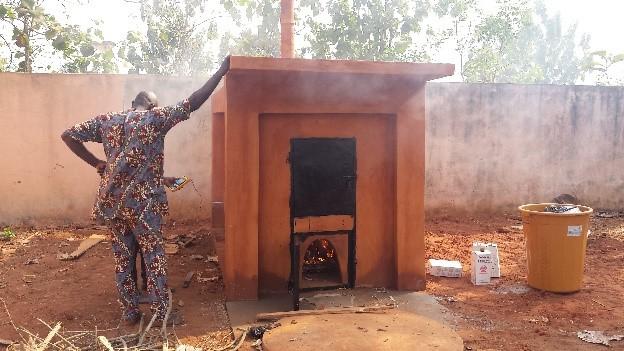
Un nouvel incinérateur valorisant les matériaux locaux
Reece-hermine ADANWENON | 22/03/2019
Une recherche-action a été initiée avec l’appui technique et financier de PASS Sourou en vue de l’amélioration de la performance de l’élimination des déchets biomédicaux solides (y compris des déchets de verrerie) produits dans les formations sanitaires. Elle a déjà connu deux phases (21 au 24 août 2018 et 11 au 14 septembre 2018) de rencontres des experts (15 personnes dont 3 femmes et un doctorant) provenant des universités, du ministère de la santé et des services déconcentrés de l’Agence Eau et Assainissement pour l’Afrique (EAA) Bénin et des artisans expérimentés (femmes de poterie de Sè et leur daumier). Ces rencontres ont permis de ressortir les réelles insuffisances qui affectent la fonctionnalité et la durabilité des incinérateurs existants (type De Montfort). Des propositions de solutions techniques appropriées ont été faites et prises dans la conception d’un nouvel incinérateur. La valeur ajoutée de cet incinérateur est la valorisation des matériaux locaux notamment le sable ferralitique et l’argile. L’usage de ces derniers se substitue aux briques réfractaires (souvent importées) et aux cheminés métalliques. Ceux-ci constituant des éléments de détérioration à travers des fissures et l’oxydation précoce. L’incinérateur a une capacité d’environ 7 fois celui du type De Montfort en mettant ensemble les deux chambres de combustion. Les portes sont semi-métalliques et semi-argileux, la cheminée est en argile cuite, et la présence d’ouvertures d’aération en bas de l’ouvrage au niveau de la chambre post combustion. Le premier modèle a été réalisé au centre de santé de Toviklin. Le test de ce modèle a regroupé tout le groupe des experts renforcé par la présence du médecin chef et son personnel (6 personnes dont 2 femmes) et de l’Administrateur gestionnaire du PASS Bureau d’Exécution de Lokossa. Le test a permis d’éliminer convenablement tous les déchets introduits dans l’incinérateur. Pendant le pré chauffage, les températures obtenues sont respectivement de 753°C dans la chambre commune et de 637°C dans la chambre de combustion (chambre primaire) au bout de 45 mn. Au cours de l’incinération, les fumées ont été bien canalisées mais quelques ajustements sont à réaliser au niveau des portillons afin d’assurer le respect optimal de l’environnement. Enfin, il est retenu de reproduire le même modèle en ramenant la capacité à 2 fois celle du type De Montfort qui intègre les différentes améliorations issues des tests.
-
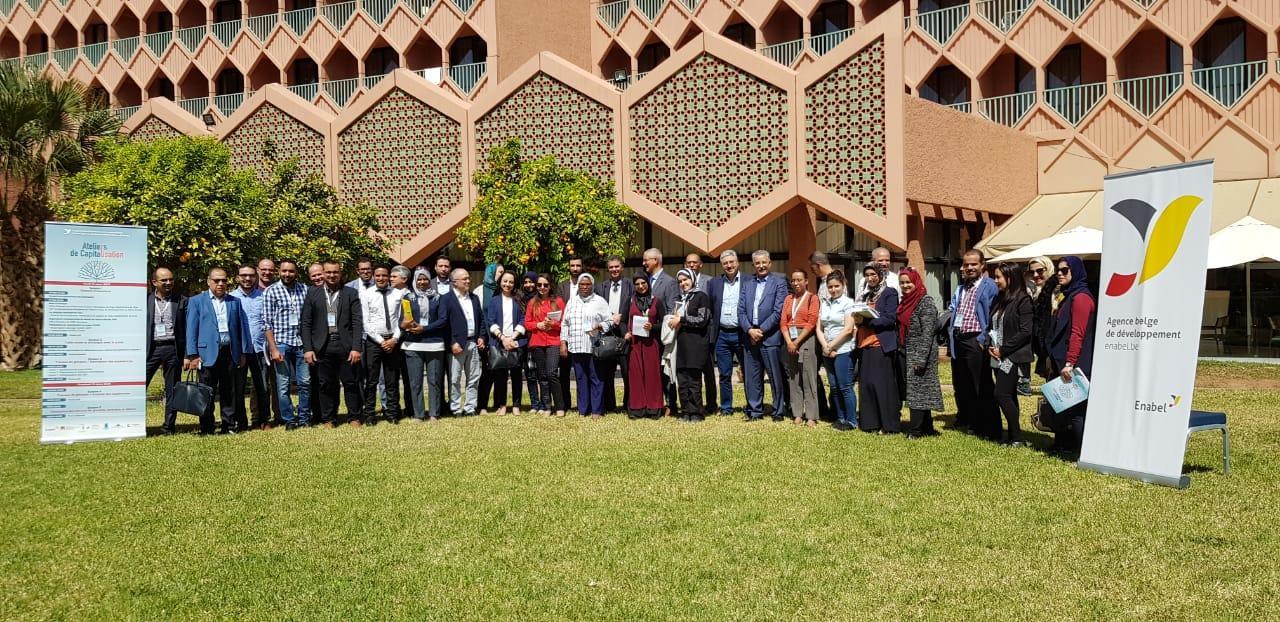
Un atelier de capitalisation de haut niveau
Meriem HILALI | 21/03/2019
Enabel a mené le projet A3ABH, main dans la main, avec le partenaire pour le renforcement de capacité des agences de bassins hydrauliques (ABH). Les agences partenaires et leurs délégations sont devenues progressivement des acteurs écoutés pour le développement local et régional et disposent désormais d’outils modernes et performants pour assurer leur mission. Les leçons retenues sont nombreuses, les plus importantes sont : 1. la responsabilisation du partenaire dans l'exécution du projet est primordial pour la pertinence des actions et l'appropriation et la durabilité des résultats ; 2. L'institutionnalisation de la communication au sein des ABH, avec les moyens nécessaires, est indispensable pour mener une véritable stratégie de communication afin de renforcer la résilience face aux RC ; 3. La digitalisation est un véritable levier de développement. Elle améliore la gouvernance des ABH et la maîtrise et le partage de l'information. Enfin, le projet doit sa réussite d'abord à la qualité de la relation humaine entre tous les acteurs impliqués.
-
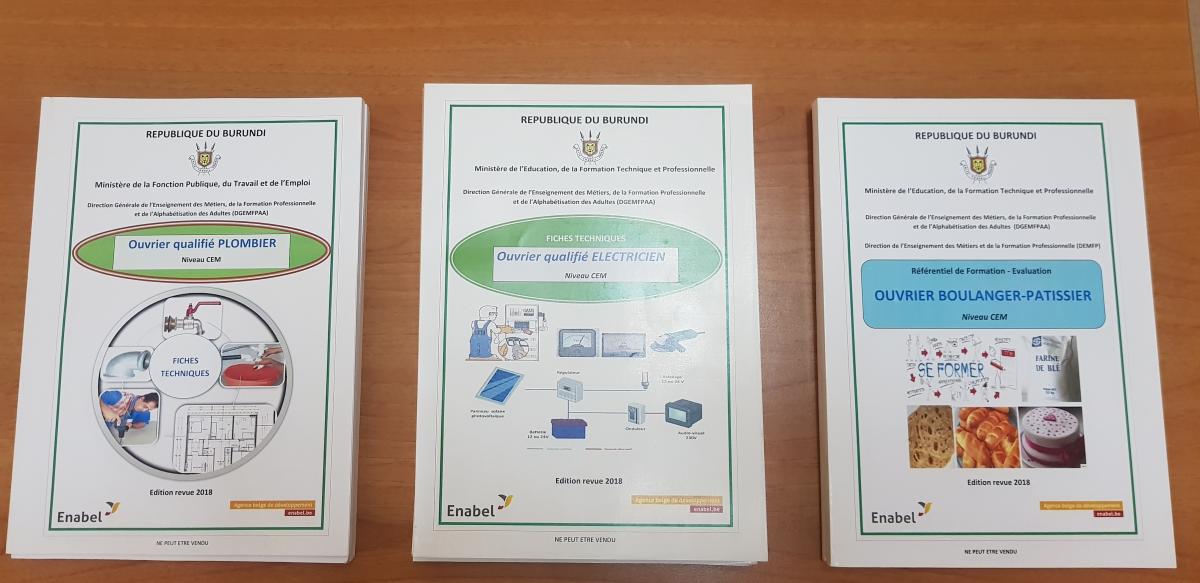
VALIDATION DES MANUELS DE FORMATION DE 20 PROGRAMMES D'ENSEIGNEMENT DES METIERS (Cycle CEM) ET REFLEXIONS SUR EFTP.
Aimé GIRUKWIGOMBA | 21/03/2019
En partenariat avec le Ministère de l'Education, de la Formation Technique et Professionnelle ; via les contributions techniques de la Direction Générale de l'Enseignement des Métiers, de la Formation Professionnelle et de l’Alphabétisation : Enabel contribue à l‘autonomisation des Centres d'Enseignement des Métiers (CEM) dans leurs rénovations et équipements, leur planification, leur gestion et à l‘accompagnement des processus éducatifs, à travers le projet « Appui Complémentaire a la Formation Professionnelle et Technique » (ACFPT), sur financement du Royaume de Belgique. Concrétèrent, ce partenariat met en place de nouvelles bonnes pratiques en formation professionnelle dans 13 centres de référence, en vue de leur extension par le Ministère dans les autres centres CEM du pays. Ces appuis ciblent quatre axes principaux, à savoir : l'axe d'accès à la formation (infrastructures et équipements), l'axe de la qualité de formation (nouveaux programmes de formation, formations de formateurs), l'axe du pilotage (gestion et stratégie des centres de formation) et celui de l'insertion des lauréats du sous- secteur (stages, leasing, entrepreneuriat). Dans ce contexte, un atelier de réflexion sur les dynamiques actuelles de formations techniques et professionnelles a été organisé le 07 novembre 2018 à Bujumbura. Cet atelier a principalement porté sur la validation des 20 manuels de formation déjà élaborés (boulangerie-pâtisserie, boucherie-charcuterie, transformation des fruits et légumes, transformation des produits laitiers, agriculture, maraîchage-horticulture, agriculture, agri-élevage, myciculture, pisciculture, mécanique vélo-moto et auto, maçonnerie, plomberie, soudure, électricité, menuiserie, couture, commis de cuisine, serveur et service en bureautique). Ces nouveaux programmes seront utilisés pour la formation en une (1) année et en approche par compétences d'ouvriers certifiés dans ces métiers porteurs d'emploi. Notons que le processus de conception des manuels va se poursuivre pour les filières innovantes à travers l'élaboration de modules de spécialisation à l'exemple de la soudure (mig-mag), de la broderie, les approches commerciales, etc. La rencontre a été également l'occasion de faire un état des lieux du secteur de I'EFTP, à la lumière des axes appuyés par le projet ACFPT. Sous le haut patronage de son Excellence Madame la Ministre de l'Education, de la Formation Technique et Professionnelle, cet atelier a donc été l'occasion de rappeler l’historique de la formation technique et professionnelle au Burundi, de dresser son bilan, son développement actuel et enfin, de réfléchir sur les processus de certification du cycle CEM en particulier et du secteur de I'EFTP en général.
-

Tekki Tour : une campagne de sensibilisation sur opportunités de réussite et de création d’emplois dans le Bassin arachidier
Aïda SECK | 21/03/2019
Dans le cadre de son Projet d’Appui à la Réduction de l’Emigration Rurale dans le Bassin Arachidier (PARERBA) financé par l’Union Européenne, l’Agence belge de développement, Enabel a initié la campagne Tekki Tour pour sensibiliser et mobiliser les jeunes et leurs familles autour d’ opportunités de réussite et de création d’emplois durables au Sénégal. Dans sa première étape, la caravane de sensibilisation a sillonné les départements de Thiès, Tivaounane, Diourbel et Bambey ; ensuite les départements de Kaolack, Kaffrine et Fatick dans une seconde étape. Les experts en employabilité et en entrepreneuriat du projet, accompagnés d’une vingtaine d’agents de sensibilisation formés et des organisations partenaires, ont pu ainsi aller à la rencontre des populations pour leur présenter l’offre du PARERBA. Point de chute des deux étapes de la caravane, les villages Tekki Fii ont été implantés à Mbour, et à Kaolack. Pendant deux jours, des stands ont été ouverts au public et animés par nos différents experts. Au programme de ces villages: des espaces d’information, des Panels Wecco Xalat, des espaces Jokko, des rencontres B2B. Au sortir de la 1ère étape du Tour, les équipes ont pu constituer une base de 903 porteurs de projets et toucher près de 25 000 personnes à travers les roadshows. Pour l’étape Kaolack, Kaffrine et Fatick, 858 porteurs de projets ont été répertoriés et plus de 23 500 personnes touchées à travers le circuit de la caravane. Enfin, le Villages Tekki Fii ont été clôturés par de grands concerts avec les artistes engagés Carlou D et Maaboo. Ces concerts qui ont rassemblé près de 16 000 jeunes à Mbour et 9500 à Kaolack ont permis de sensibiliser les populations sur les alternatives durables à l’émigration rurale et les opportunités d’intégration économique et sociale dans leurs localités. Dans ses prochains jalons, le PARERBA consacrera un volet important à l’accompagnement des jeunes autoentrepreneurs, au renforcement de capacités et au financement des projets productifs.
-
workshop on Food safety in Danang
Krista VERSTRAELEN | 20/03/2019
https://eng.vnua.edu.vn/news-and-events/danang-is-funded-to-build-a-food-smart-city-33669.html
-
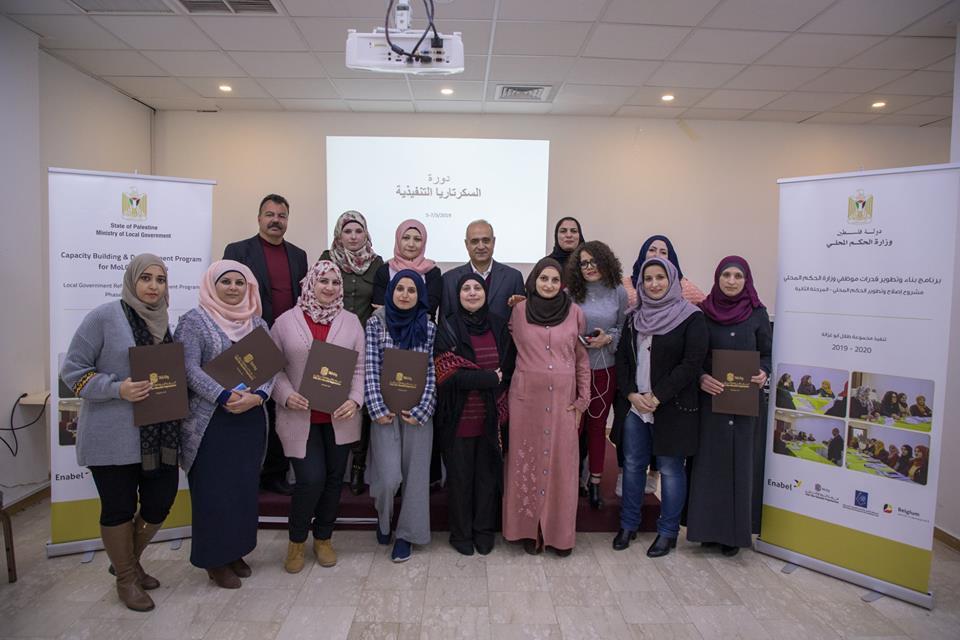
The Ministry of Local Government launches the Capacity Building and Development Program for the MoLG staff
Laura SCHILLEMANS | 18/03/2019
The department of Human Resources Development of the Ministry of Local Government concluded a training course called "Executive Secretariat". The training was organized for employees from all directorates and departments in the ministry.This training is part of the Ministry’s vision and strategy to develop the capabilities of its employees in order to provide the best services to LGUs or citizens.Safwan Al Halabi, Director General of the Human Resources Development Department at the Ministry of Local Government, said “The executive plan of the HR Department is to work with all donors in 2019, targeting all the different departments in the ministry and directorates." Yara Njoom, an employee of the Project department, said "As a new employee in the ministry, I acquired many new skills. I learned how to deal with citizens, how to work with my computer software and the file archiving system, as well as how to handle incoming mail and reporting mechanisms." "This course represents the first of the outputs of the capacity building program for the employees of the Ministry of Local Government, which was launched by the ministry for the duration of one year.” said Doaa’ Qutub from Enabel.------------ This training is part of the Local Government Reform and Development Program (LGRDPII), which is implemented by the Ministry of Local Government in collaboration with the Municipal Development and Lending Fund, funded by the Belgian government through Enabel
-

Protection des bassins versant via les boisements
Diane NSENGIYUMVA | 28/02/2019
Dans le cadre de la mise en œuvre du PAIOSA, des activités de reboisement ont été réalisés dans les bassins versants du périmètre irrigué de l Imbo Nord selon l’approche de Gestion participative et communautaires. Ce vidéo montre les membres du Groupement de gestion forestière pendant les travaux d’entretien et de protection d’un boisement.
-
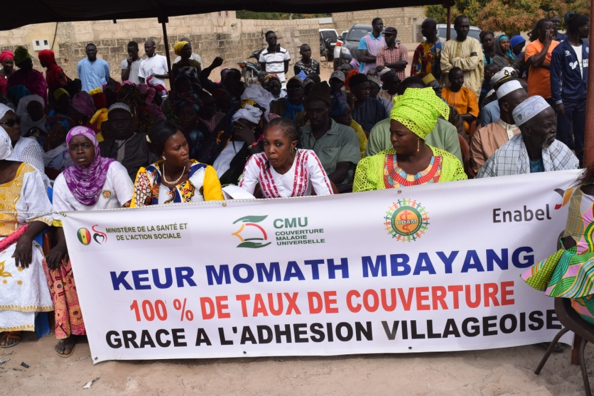
Assurance Santé en Afrique Sub-Saharienne
Aïda SECK | 26/02/2019
De 2012 à 2017, la coopération gouvernementale belge et les autorités sénégalaises ont mis en œuvre un projet de 17 millions d'euros pour soutenir l'offre et la demande de services de santé visant à organiser l'assurance maladie pour les ruraux pauvres (PAODES1). Le projet avait pour objectif de développer une approche durable visant à apporter une assurance maladie aux communautés rurales du Sénégal. PAODES a accompagné le ministère de la Santé dans ses efforts pour réformer les structures de financement des soins de santé, en mettant en place un système d'assurance maladie et en rationalisant les services de soins de santé de base aux niveaux local et du district. En fin de compte, l’ambition du projet était de proposer au ministère de la Santé un modèle d’assurance maladie pour les ruraux pauvres, qui avait été testé suffisamment longtemps et à une assez grande échelle pour en tirer les enseignements en vue de l’extension du modèle. Pour consulter cet article, cliquez su le lin: https://www.enabel.be/sites/default/files/006_introducing_large-scale_health_insurance_for_the_rural...
-
workshop on Food safety in Danang
Krista VERSTRAELEN | 26/02/2019
The study "Mapping of food value chains and formulation of a food smart city strategy by 2025 with a vision towards 2030 for Danang city" is carried out by Vietnam National University of Agriculture (VNUA) with the Food Safety Management Authority of Danang, supported also by Rikolto (Belgian NGO). This dynamic workshop brought several stakeholders together, with participation from Rikolto &Prof. E. Mathijs (KULeuven)
